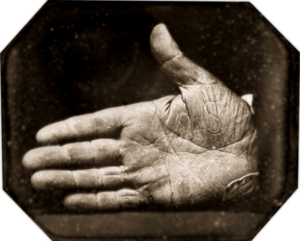Jonathan Walker (abolitionist)
Jonathan Walker | |
|---|---|
 Jonathan Walker in 1848 from an engraving in the book, Trial and imprisonment of Jonathan Walker: at Pensacola, Florida, for aiding slaves to escape from bondage, published by the Massachusetts Anti-Slavery Society in Boston. | |
| Born | 1799 |
| Died | May 1, 1878 (aged 77–78) |
| Other names | The Man with the Branded Hand |
| Occupation(s) | Reformer, fisherman, railroad worker |
| Known for | Arrested for helping runaway slaves |

Jonathan Walker (1799 – May 1, 1878), known as "The Man with the Branded Hand", was an American fishing ship captain and abolitionist who became a national hero in 1844 when he was tried and sentenced as a slave stealer following his attempt to help seven runaway slaves find freedom. He was branded on his hand by the United States Government with the markings "S S", for "Slave Stealer".
Biography
Jonathan Walker was born in Harwich, Massachusetts in 1799. During his youth in Massachusetts, Walker learned to sail and became captain of a fishing vessel. In early 1837, he went to Florida and became a railroad contractor. The condition of the slaves interested him, and in 1844 Walker aided several of them as they attempted to make escape in an open boat from the coast of Florida to the British West Indies, where slavery had been abolished ten years before. After doubling the capes, Captain Walker fell seriously ill; the crew, being ignorant of navigation, would all have been drowned if a wrecking sloop had not rescued them and taken Walker to Key West. From there, he was sent in chains aboard USS General Taylor to Pensacola, where he was put in prison, chained to the floor, and deprived of light and proper food. Walker later wrote about the degrading conditions inside the jailhouse and the brutality shown toward slaves there.
Put on trial in federal court in Pensacola, Walker was convicted, heavily fined, and sentenced to be tied to a pillory, and publicly branded on his right hand with the letters "S S" (for "slave stealer"). But to sympathizers,[who?] it meant "Slave Savior". United States Marshal Eben Dorr, who also traded slaves, executed the branding with a hot iron.[1] Walker was then returned to jail, confined eleven months, and released only after Northern abolitionists paid his fine.[citation needed] For five years after his release, Walker lectured on slavery in the Northern and Western states. For instance, in 1847/48, he was on a four-and-a-half-month lecture tour together with John S. Jacobs.
Walker—along with Stephen Symonds Foster and Abby Kelley Foster, Sojourner Truth, Marius Robinson, and Sallie Holley—reorganized the Michigan Anti-Slavery Society in 1853 in Adrian, Michigan.[2] The state society was founded in 1836 in Ann Arbor, Michigan.[3]
He lived in Wisconsin in 1855 [4] and 1860 [5] near Winooski, Wisconsin. He moved to Michigan around 1866 and lived near Muskegon.
Jonathan Walker died on May 1, 1878, in Lake Harbor near Norton Shores, Michigan. He is buried at Evergreen Cemetery in Muskegon.[6] His wife Jane Gage Walker (1803-1871) is buried at Norton Cemetery, Norton Shores, Michigan. Their two youngest sons (born in 1843 and 1848) predeceased their parents, but two sons and five daughters survived both parents.
Legacy

A monument was erected to Captain Walker's memory on August 1, 1878. The monument was funded by abolitionist Photius Fisk, who funded several monuments for abolitionists.
The monument became a national shrine for those working towards racial justice.[7]
Walker was the subject of John Greenleaf Whittier's poem "The Branded Hand".[8] Whittier learned about Walker by reading a book about him called Trial and Imprisonment of Jonathan Walker (1850).[9] The poem praised Walker's actions.[10]
A plaque commemorating Walker was erected on the lawn next to the Harwich, Massachusetts, Historical Society. Another Rev. John Walker (1786–1845) was a Presbyterian minister and abolitionist in Pennsylvania and Ohio who founded Franklin College in Ohio.[11]
In 2013, Walker was inducted into the National Abolition Hall of Fame, in Peterboro, New York.
See also
References
- ^ Karen Jeffrey (2009-03-05). "Captain Jonathan Walker". Captjonathanwalker.blogspot.com. Retrieved 2017-10-20.
- ^ Coggan, Blanche (1964). "The Underground Railroad In Michigan". Negro History Bulletin. 27 (5): 125–126. ISSN 0028-2529. JSTOR 44174961 – via Jstor.
- ^ Mull, Carol E. "Signal of Liberty". Ann Arbor District Library. Retrieved 2022-03-30.
- ^ "Wisconsin State Census, 1855, town of Lyndon, Sheboygan County". FamilySearch. Retrieved 2019-02-12.
- ^ United States Census, 1860; State of Wisconsin, County of Sheboygan, Town of Lindon, page 51, lines 4-10
- ^ "Jonathan Walker". Nndb.com. Retrieved 2017-10-20.
- ^ Hodge, Lyman F. (1891). Photius Fisk A Biography. Boston, Mass: Lyman F. Hodge. p. 136.
- ^ "John Greenleaf Whittier's poem: The Branded Hand". Retrieved 2015-02-03.
- ^ "Full text of "A Short Sketch of the Life and Services of Jonathan Walker: The Man with a Branded Hand with a ..."". Chronicle Steam Printing House. 2016-10-23. Retrieved 2017-10-20.
- ^ Ehrlich, Eugene and Gorton Carruth. The Oxford Illustrated Literary Guide to the United States. New York: Oxford University Press, 1982: 264. ISBN 0195031865
- ^ "John Walker". Archived from the original on 2015-02-03. Retrieved 2015-01-26.
Further reading
- Walker, Jonathan (1845). Trial and imprisonment of Jonathan Walker at Pensacola, Florida, for aiding slaves to escape from bondage : with an appendix, containing a sketch of his life. Boston.
- Jonathan Walker: The Man with the Branded Hand by Alvin F. Oickle. Westholme Publishing, 2011. ISBN 978-1-59416-136-0
- Branded Hand by Elmer Koppelmann[full citation needed]
- Wilson, Henry, The History of the Rise and Fall of the Slave Power in America. Boston, 1874.
- "Trial and Imprisonment" by Jonathan Walker[full citation needed]
- Jonathan Berger, "White Suffering and the Branded Hand", Mirror of Race.
- Kittredge, Frank Edward. 1899. The Man with the Branded Hand: An Authentic Sketch of the Life and Services of Capt. Jonathan Walker. HL Wilson Printing Company.
